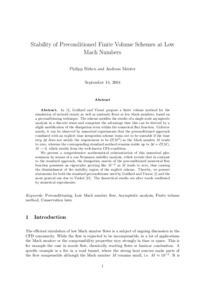Stability of preconditioned finite volume schemes at low Mach numbers
| dc.date.accessioned | 2006-04-25T12:42:09Z | |
| dc.date.available | 2006-04-25T12:42:09Z | |
| dc.date.issued | 2004 | |
| dc.identifier.uri | urn:nbn:de:hebis:34-2005071252 | |
| dc.identifier.uri | http://hdl.handle.net/123456789/2005071252 | |
| dc.format.extent | 156678 bytes | |
| dc.format.mimetype | application/pdf | |
| dc.language.iso | eng | |
| dc.publisher | Universität Kassel, FB 17, Mathematik/Informatik | eng |
| dc.rights | Urheberrechtlich geschützt | |
| dc.rights.uri | https://rightsstatements.org/page/InC/1.0/ | |
| dc.subject | Preconditioning | eng |
| dc.subject | Low Mach number flow | eng |
| dc.subject | Asymptotic analysis | eng |
| dc.subject | Finite volume method | eng |
| dc.subject | Conservation laws | eng |
| dc.subject.ddc | 510 | |
| dc.title | Stability of preconditioned finite volume schemes at low Mach numbers | eng |
| dc.type | Preprint | |
| dcterms.abstract | In [4], Guillard and Viozat propose a finite volume method for the simulation of inviscid steady as well as unsteady flows at low Mach numbers, based on a preconditioning technique. The scheme satisfies the results of a single scale asymptotic analysis in a discrete sense and comprises the advantage that this can be derived by a slight modification of the dissipation term within the numerical flux function. Unfortunately, it can be observed by numerical experiments that the preconditioned approach combined with an explicit time integration scheme turns out to be unstable if the time step Dt does not satisfy the requirement to be O(M2) as the Mach number M tends to zero, whereas the corresponding standard method remains stable up to Dt=O(M), M to 0, which results from the well-known CFL-condition. We present a comprehensive mathematical substantiation of this numerical phenomenon by means of a von Neumann stability analysis, which reveals that in contrast to the standard approach, the dissipation matrix of the preconditioned numerical flux function possesses an eigenvalue growing like M-2 as M tends to zero, thus causing the diminishment of the stability region of the explicit scheme. Thereby, we present statements for both the standard preconditioner used by Guillard and Viozat [4] and the more general one due to Turkel [21]. The theoretical results are after wards confirmed by numerical experiments. | eng |
| dcterms.accessRights | open access | |
| dcterms.creator | Birken, Philipp | |
| dcterms.creator | Meister, Andreas | |
| dcterms.isPartOf | Mathematische Schriften Kassel | eng |
| dcterms.isPartOf | 04, 09 | eng |
| dc.subject.swd | Numerische Mathematik | ger |
| dcterms.source.journal | Mathematische Schriften Kassel | |
| dcterms.source.volume | 04, 09 |

